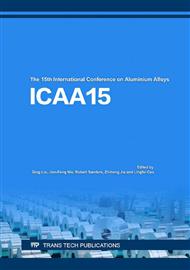p.601
p.606
p.611
p.617
p.625
p.635
p.640
p.647
p.655
A Novel Methodology for Optimization of Properties, Costs and Sustainability of Aluminium Extrusions
Abstract:
The present paper describes an innovative methodology that has been developed for optimization of product properties, production costs, and environmental impact in fabrication of aluminium alloys. The main idea is to represent each operation along the process chain by predictive models, which include material, mechanical, cost, and sustainability models. A multi-objective optimization platform is used to combine the models into a common software environment, which allows fully automatic simulations. The optimization tool runs the models in iterations until user-defined acceptance levels on properties, costs, and sustainability indices are obtained. In this paper, the methodology has been applied for fabrication of 6xxx-series aluminium extrusions. As a demonstration of practical relevance, the software tool was used to optimize mechanical properties and electrical conductivity by manipulation of alloy chemistry, processing parameters, and microstructure characteristics like grain structure, precipitates, dispersoids, and solid solution concentrations. At the same time material and production costs, as well as CO2 emissions along the value chain were attempted to be kept at minimum levels.
Info:
Periodical:
Pages:
625-632
Citation:
Online since:
November 2016
Authors:
Keywords:
Price:
Сopyright:
© 2017 Trans Tech Publications Ltd. All Rights Reserved
Share:
Citation:


